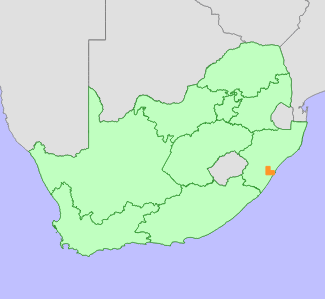|
Scientific Name | Aloe parviflora Baker |
Higher Classification | Monocotyledons |
Family | ASPHODELACEAE |
Synonyms | Leptaloe parviflora (Baker) Stapf |
National Status |
Status and Criteria | Vulnerable B1ab(ii,iii,iv,v)+2ab(ii,iii,iv,v) |
Assessment Date | 2019/05/07 |
Assessor(s) | H. Mtshali |
Justification | Aloe parviflora is a range-restricted species with an extent of occurrence (EOO) of 120 km², and an area of occupancy (AOO) of 40 km². An estimated six to 10 locations remain on isolated grassland remnants after at least 74% habitat loss, predominantly to urban expansion. It continues to decline due to ongoing habitat loss and degradation. |
Distribution |
Endemism | South African endemic |
Provincial distribution | KwaZulu-Natal |
Range | Due to taxonomic uncertainty, this species' range is poorly known. It is possibly endemic to a small area in central KwaZulu-Natal, between Cato Ridge and Pinetown. |
Habitat and Ecology |
Major system | Terrestrial |
Major habitats | KwaZulu-Natal Sandstone Sourveld, Ngongoni Veld, KwaZulu-Natal Hinterland Thornveld |
Description | It occurs in rocky grasslands, typically associated with Natal Group Sandstone. |
Threats |
| At least 74% of this species' habitat has been irreversibly modified, mainly as a result of urban expansion. It persists mainly on small fragments, where the species can be locally common, but continues to be threatened by competition from alien invasive plants, inappropriate fire management and ongoing loss to development. Subpopulations on larger remnants are threatened by overgrazing and too frequent fire. |
Population |
Aloe parviflora is a localized species, known from only a few records. It is possibly overlooked due to taxonomic confusion with Aloe minima. It is likely to be locally extinct at most localities known through historical records, but field surveys are needed to confirm this. According to Craib (2005), it is locally common in small remnant grassland patches around Pinetown and Botha's Hill. A continuing decline is inferred from ongoing habitat loss and degradation.
|
Population trend | Decreasing |
Notes |
| Aloe parviflora is difficult to distinguish from Aloe minima, and possibly does not warrant recognition as a separate species (Van Wyk and Smith 2014). Further study is needed. |
Assessment History |
Taxon assessed |
Status and Criteria |
Citation/Red List version | | Aloe parviflora Baker | VU B1ab(ii,iii,iv,v)+2ab(ii,iii,iv,v) | 2020.1 | |
Bibliography |
Carter, S., Lavranos, J.J., Newton, L.E. and Walker, C.C. 2011. Aloes: The Definitive Guide. Royal Botanic Gardens, Kew.
Craib, C. 2005. Grass Aloes in the South African Veld. Umdaus Press, Hatfield.
Reynolds, G.W. 1969. The Aloes of South Africa. A.A. Balkema, Cape Town.
Smith, G.F., Steyn, E.M.A., Victor, J.E., Crouch, N.R., Golding, J.S. and Hilton-Taylor, C. 2000. Aloaceae: The conservation status of Aloe in South Africa: an updated synopsis. Bothalia 30(2):206-211.
Van Wyk, B.-E. and Smith, G.F. 2014. Guide to the Aloes of South Africa. (Third ed.). Briza Publications, Pretoria.
|
Citation |
| Mtshali, H. 2019. Aloe parviflora Baker. National Assessment: Red List of South African Plants version 2024.1. Accessed on 2025/12/23 |
 Comment on this assessment
Comment on this assessment

